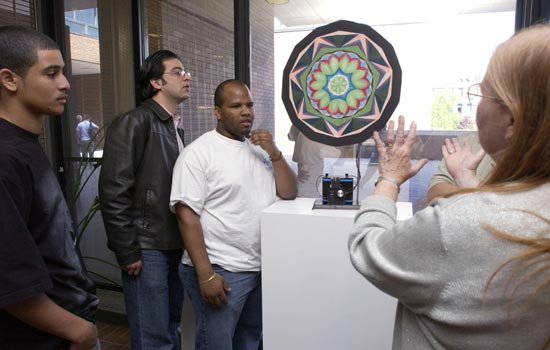Project helps students beautifully blend art and engineering
A. Sue Weisler | photographer
Stephanie Kirschen Cole talks with members of RIT’s student chapter of the Society of Hispanic Professional Engineers about a motorized display board that students designed to show kaleidoscope art in motion. From left are chapter members Ariel Enriquez, Jorge Daccarett and Ramon Campusano, chapter president.
Art and engineering intersected in a recent project involving Foundations students, in RIT’s College of Imaging Arts and Sciences, and a group of RIT engineering students. For years, students in Stephanie Kirschen Cole’s 2-D Design course have created computer-designed, hand-painted kaleidoscope-like paintings. Because kaleidoscope art is most interesting while in motion, however, someone had to physically spin the compositions to enhance the visual effect. But no longer, after members of RIT’s student chapter of the Society of Hispanic Professional Engineers stepped in.
They created a motorized display board that, with the flip of a switch, turns a kaleidoscope painting into a spinning work of art. The result: a kaleidoscope in motion—as it’s meant to be—bursting with color and even new colors. “We find that they actually transform, producing new colors,” says Cole, explaining the phenomena of an optical perception of color change. The kaleidoscope is the perfect tool, she suggests, for the study of color and color theory topics covered in 2-D Design. In creating the motorized display board, the 15-member group of Hispanic engineering students designed a device with a sturdy base, an arm and a plate with Velcro to hold the painting in place, a motor powered by a 12-volt battery, and a potentiometer to regulate speed.
One of the first project challenges, says chapter president Ramon Campusano, a second-year computer engineering major, was securing the painting to the metal plate without using a screw. “Don’t touch the front,” he says about the design consideration that leaves the painting untouched. The device, demonstrated in Bevier Gallery last spring, is a prototype. But for Cole, who for years has showcased her students’ nonmoving artwork behind glass, the invention has given her colorful visions of grandeur. “This is just a starting point,” she says. “I have this vision of well over 20—all spinning at the same time. This project has been very significant because of its interdisciplinary focus of art and technology.” Adds Benjamin Varela, assistant professor of mechanical engineering and chapter advisor: “This was a very interesting project because it involved art and engineering. Students had an opportunity to learn outside the classroom from other disciplines and to exercise their team building skills—and it was fun!” The kaleidoscope project wrapped up a successful year for the 15-member student chapter, which last spring captured first place in a Project Management Institute competition and second place in a contest sponsored by APICS—the Association for Operations Management.
This October, chapter members will compete in the APICS International Conference and Expo national competition in Denver. In addition, the Xerox Foundation awarded scholarships to chapter members, funded the development of projects such as the kaleidoscope motorized display board, and supported students’ attendance at the National Technical & Career Conference 2007, sponsored by the Society of Hispanic Professional Engineers, in Denver.









